
Salty Sam’s Fun Blog for Children
Number 198
The Cure for Cholera
Hello Everyone

When l was telling you about famous sea canals in Blog Post 195, l told you about how men building the Panama Canal got ill from contracting tropical diseases.
They were bitten by mosquitoes that were carrying disease and the disease was transferred into the men’s blood. These insects suck blood for food.
When the men became ill, the legs of their beds were stood in pans of water. The idea was that the water would stop insects crawling from the floor onto the beds, but the practice made the situation worse.
Mosquitoes are flying insects that breed in stagnant water. The pans of water gave the insects more opportunity to breed. The people in the hospitals didn’t know that what they were doing was a bad idea because they didn’t understand how people got malaria or yellow fever.

lt is always better to try and prevent a disease rather than cure it. We can feel sad that this happened or even scoff at the ignorance but we learn from the mistakes and discoveries of the past.
Sometimes scientists have an idea about how something works – this is called a theory, then they test it out – this is called an experiment.
Sometimes scientists learn things by watching a situation. This is called observation.
But sometimes people discover things just by noticing something that happens during the course of their every day work. This can happen, for example, with doctors who see lots of patients. Then their observation is tested further to find proof.
My story this week is about one such discovery. lt led to our understanding of how a terrible disease called cholera is contracted. Unlike malaria which is transferred by flying insects; cholera is a water-borne disease caused by bacteria. That means if you drink water that contains cholera, you will get ill.
Cholera may well have originated from the Ganges Delta in lndia where poor living conditions and the presence of many pools of still water gave it the perfect conditions to thrive.
lt travelled to the rest of the world when people started trading with each other. The people carried the disease with them. There are still outbreaks of cholera today in developing countries, especially when earthquakes or tsunamis damage cities and their water supplies and sewage systems.
But there were terrible pandemics (wide-spread illness) that hit various parts of the world in the 1800s killing many millions of people. Even the French king, Charles X, died of cholera in 1836.
lf a ship was carrying cholera, it flew a quarantine flag and would not be allowed ashore for over a month. (The modern quarantine flag is shown at the top of my post.) But the disease still spread.
ln modern times, Cholera is no longer considered a threat in Europe and North America because of the availability of clean drinking water and the safe removal of sewage.
lt was a medical doctor called John Snow who found a link between human sewage contamination of drinking water and outbreaks of the disease.
Before that, people believed that cholera was caused by bad air. They didn’t know about germs.
ln the late summer of 1854, there was an outbreak of cholera in Soho, an area of Central London. One hundred and twenty seven people died within three days. Five hundred died within ten days, and six hundred and sixteen by the end of the outbreak.
A healthy person can die within hours after contracting this illness.
Snow’s natural curiosity led him to investigate the situation. He believed that he would be able to find some connection between the people who had died.
By talking to local residents Snow found out that the one thing that all the ill people had in common was that they collected their drinking water from a water pump in Broad Street. ln those days, people did not all have water taps inside their houses, they had to go out into the street and collect it from a pump that everyone shared.
Few houses before the 20th century had a water supply. Water was collected from street pumps called conduits or delivered by men called water-carriers.
Snow persuaded the local council to remove the pump handle so that it could no longer be used.
He also noticed how the men who worked in the local brewery had not contracted the illness. They had been partly paid in beer and so they and their families had a habit of drinking beer rather than water.
The production of ale and beer requires boiling of water which kills any disease that it might contain.
The monks in the nearby monastery too, did not catch the disease because they were drinking beer from their own brew house.
Then Snow created a map to pinpoint the location of all the ill people. lt showed how they all lived in one area.
At this time, there had been an increase in the number of people living in this area, but the London sewage system had not yet reached Soho.
Many houses had a cess pit underneath the floorboards which is where the sewage from the house collected. The idea was that it should soak into the ground, but since many of these pits were overflowing, the sewage was collected and put into the River Thames.
The illness occurred because water was taken from the polluted river for the people to drink. Also, the pump had been situated only three feet from an old cesspit where sewage remained. lt was a disaster waiting to happen.

Snow did do other experiments to try and help stop the suffering that illnesses cause. The most famous were the ones that he did to improve anaesthesia. This means drugging someone before they have an operation.
But what he is most remembered for is the discoveries he made that would help prevent cholera.
lt was a major contribution to our knowledge of how disease can be spread and also be prevented.
Bye bye everyone – don’t forget to subscribe to my blog!
lf you like my blog, please support it by telling all your friends and followers about it.
Thank you!
And see you again next Fun Friday!
Love and kisses
Salty Sam

www.christina-sinclair.com


Bill and Bob’s Joke of the Week![]()
![]()
Bob: A man went to see the doctor and said, “What is wrong with me doctor?”
Bill: So what did the doctor say?
Bob: He said, “Well, you’ve got a carrot up your nose, a runner bean stuck in one ear and a sausage stuck in the other. l would say that you’re not eating properly!”

Salty Sam © Christina Sinclair 2015
Unauthorized use and/or duplication of material from this blog without express and written permission from this blog’s author and owner is strictly prohibited.
Links may be used to www.christina-sinclair.com

Picture Gallery

John Snow

The map of Soho created by Snow and drawn by Charles Cheffins

A memorial to John Snow and a pub named after him in Soho

Reverend Whitehead from St Luke’s church helped Snow gather vital information in the 1854 cholera outbreak
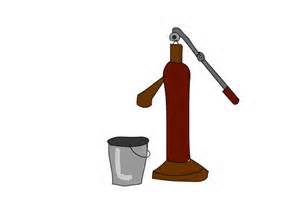
A water pump
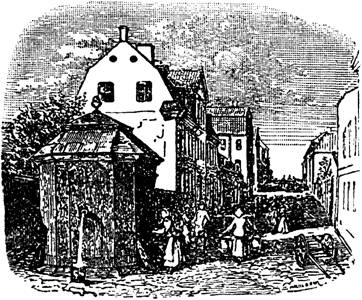
Before modern indoor plumbing, water was collected from pumps in the street

A court yard water pump
Hampton Court Palace

The John Snow Pub in Soho
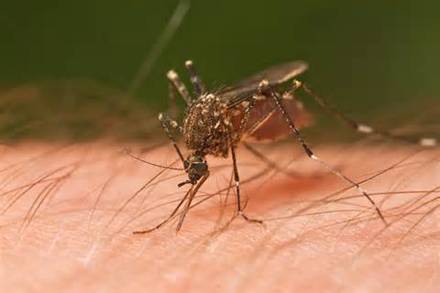
There are many different species of mosquito

The red blotches of cholera on skin (model)
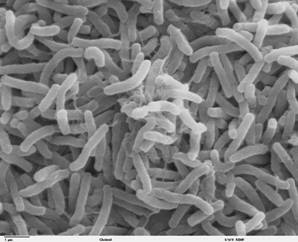
Cholera bacteria

Charles X of France (1757-1836)
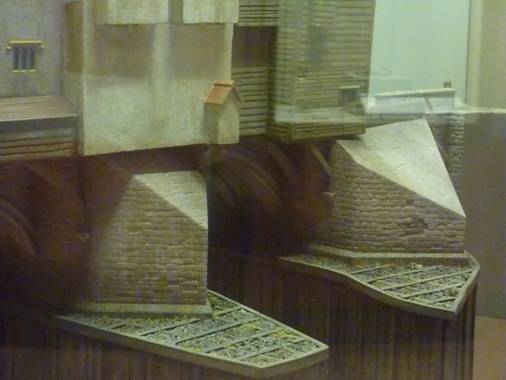
A garderobe toilet on the mediaeval London Bridge
It had been a long tradition to dump sewage in the River Thames
but as London’s population grew the danger to health grew too


 THE SALTY SAM NEWS DESK
THE SALTY SAM NEWS DESK

Bill and Bob have been working hard yet again compiling questions for their team in preparation for their next Friday afternoon class quiz.
The groups are all preparing some questions that relate to compound nouns or adjectives. They are things or describing words made of two words.
Bill and Bob chose to select six words that all began with the word ‘water’ so of course their puzzle fits in well with the theme of this week’s blog.
Miss Pringle always gives the class plenty of notice when she is going to run a quiz afternoon. But it seems to have become quite a regular thing now.
Between you and me she is glad that there is one lesson in the week that she doesn’t have to prepare herself – the children do it for her!
See if you can answer Bill and Bob’s questions…
Can you complete these words?
- the downward progress of a stream or river = water_ _ _ _
- floating but full of water = water_ _ _ _ _ _
- someone who works on boats = a water_ _ _
- a mark made in paper during manufacture = a water_ _ _ _
- a sport played in a swimming pool = water _ _ _ _
- will not let water in = water_ _ _ _ _
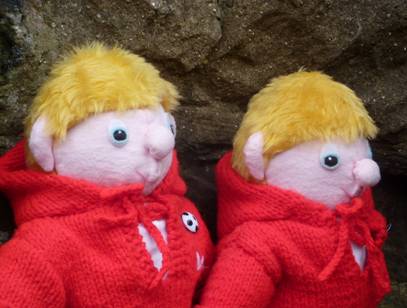

Talking about water; I don’t think I ever told you about a funny story that happened in Rocky Bay a few winters ago.

As you already know, water can exist in three states; when it gets really hot it becomes steam and when it becomes really cold it becomes ice.
Do you remember that really cold winter a few years back when we had lots of snow? Well, if you are too young to remember, never mind.
It got so cold one night that the lions in the Rocky Bay Animal World woke up to find the moat around their enclosure had frozen over!
So they decided to take a walk.
They crossed the moat, walked down the path (which created quite a stir in the other enclosures I can tell you) and then they kept on walking right into the town!
One little boy, eager to get to school, was up early and looked into the darkness of the street from his bedroom window to see a lion walking down the pavement.
As you can imagine, he thought that he was still dreaming!
His mum didn’t believe what he was telling her until she saw two large, golden eyes looking in at her through the kitchen window while she was filling the kettle to make some tea.
She telephoned the police and they radioed to Calico Jack on his pirate radio ship.
He broadcasted the warning on his breakfast radio show that everyone should stay inside and lock their doors and windows. People sent text messages to their family and friends and neighbours so that everyone would be sure to get the message.
Because there was deep snow outside of course everyone had their doors and windows shut anyway – and a lot of people had already decided that they weren’t going to be able to get to work so were already staying in the warmth of their beds and having a lie in.
![]()
Calico Jack and I were safe because we were both way out to sea but the people of the town were all trapped in their houses waiting for the lions to be found and rounded up.
The Rocky Bay Animal World keepers leapt into action and prowled the streets with dart guns looking for the lions.
In the half-darkness of the winter dawn, the lions made it all the way down to the Rocky Bay Harbour before they were spotted again. Reg, the landlord at the Rusty Anchor, saw them from his front window.
There are strange goings-on at the Rusty Anchor sometimes, but even he had to rub his eyes and look again!
Well, the lions decided not to go for a swim in the sea on such a cold day, and after Reg had telephoned the police the lions were cornered at the end of the harbour wall and recaptured.
When they were put back in their cage the keepers locked the doors and the lions had to stay inside until all the snow had melted. Actually, they didn’t mind because the lions seemed to like the warmth much better than the cold snow – and they were quite worn out after their big adventure anyway.
It was after this escapade that it was decided to transfer the lions to the Rocky Bay Safari Park where they would have much more room to roam about – and very tall fences to keep them in no matter how high the snow got!
So as you can see, it was a happy ending for everyone. ![]()


*********************
TO ADVERTISE ON THIS BLOG
PLEASE CONTACT:
christina.sinclair.ads@aol.co.uk
*********************


Crafty Tip
This is a really easy way to make paper, snowy-scene, window friezes.
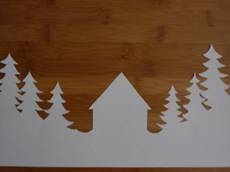
- Get a piece of white A4 paper and turn it sideways.
- Put the ground about two ruler widths up from the bottom of the paper so that there is a solid base at the bottom of the frieze.
- Place a rectangular box on the top line and draw around it.
- Draw a roof on top of the rectangle.
- Draw some conifer trees each side of your cabin – these are easy shapes to draw.
- Draw snowdrifts between the cabin and the trees.
- Cut out the silhouette – cut into the shapes as you go, rather than around them in order to get crisp edges.
- Tape your frieze to the base of a window pane.
- Draw a cabin-in-the-forest picture for every window pane and your windows will have very striking decorations.
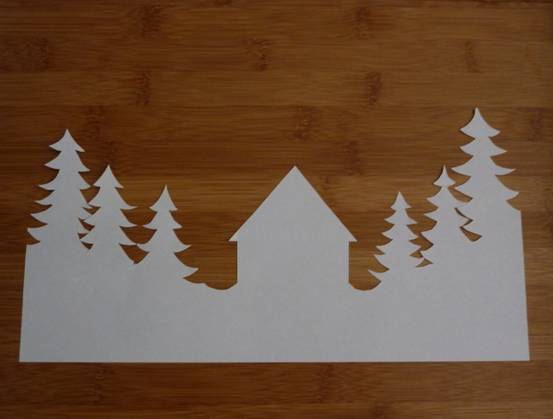
Of course, you could draw a town scene with a row of houses and trees if you prefer, and if you have very large windows you could tape strips of friezes together.
lf you are very nimble-fingered, you could cut doors and windows in them to make them look even prettier.
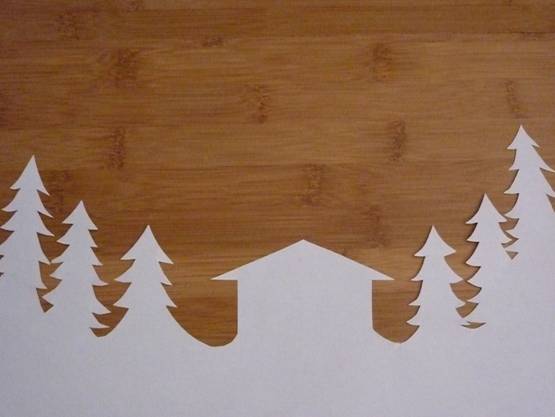
You could even spray snow on the window above the landscape.
lf you start making some paper snow scenes now, they will be ready to use next month to decorate your classroom or house windows.

BLOW MY FOGHORN!!!

PLUS
Salty Sam fans can join in with their comments and share them with children all over the world. You will need to ask permission if you are not an adult.
Enter your e-mail address to subscribe to my blog and receive new Salty Sam Blog Posts for free by e-mail every week. Your address will be kept private and will not be shared with any third party.
Sign me up at the side bar




lt’s the Weekend!
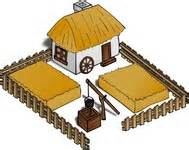
HOW TO MAKE A HOUSE TlSSUE BOX COVER
If you are ever ill, you may take a box of tissues to bed with you.
This little house might make you feel a little more cheerful if you have the snuffles – the chimney puffs out tissues.
This tissue box cover is designed to fit a box:
11cm wide
10cm deep
12cm high
You will need two sheets of plastic canvas 26.7cm by 34.3cm
The front and back are each 33 holes high by 32 holes wide
The two sides are 33 holes high and 27 holes wide
The top is 32 holes by 27 holes with a hole cut in the middle leaving rows of six holes around the edge
The chimney fits into the hole and is 11 holes tall:
Two panels – 20 holes by 11 holes
Two panels – 15 holes by 11 holes
Stitch the roof and gutter and then the door frames and window frames then filling in the rest will be easy (you might find it easier to put guide lines in before you stitch on the doors and windows).
- The roof has four lines of stitching and the gutter is one row below that.
- The front door has a little window the back door has a large glass panel in it.
- The curtains are three columns on the large windows and two in the small windows.
- The side panels have the large windows in the same position as on the front and back walls.
- The drain pipes have four stitches top and bottom and runs of two stitches between.
- The top pieces are stitches in red with the exception of one line of white stitches along the top of the chimney pieces.
TO MAKE UP
- Sew the bottom of the chimney pieces to the edges of the hole in the top piece right sides together.
- Sew up sides of chimney.
- Sew tops of walls to the edge of the top wrong sides together.
- Sew down corners of the house (red at the corners of the roof and gutters and white at the corners of the walls).
- Sew along the top edge of the chimney and the base of the walls using white yarn.
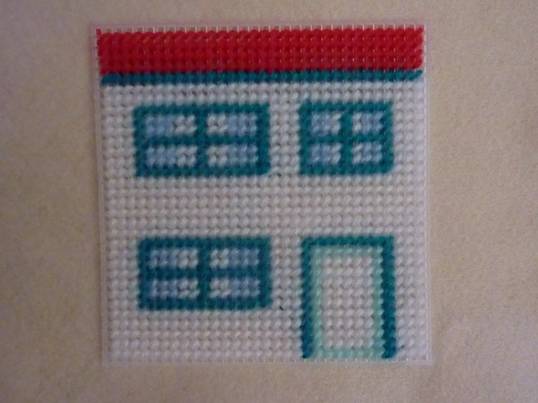
Back panel
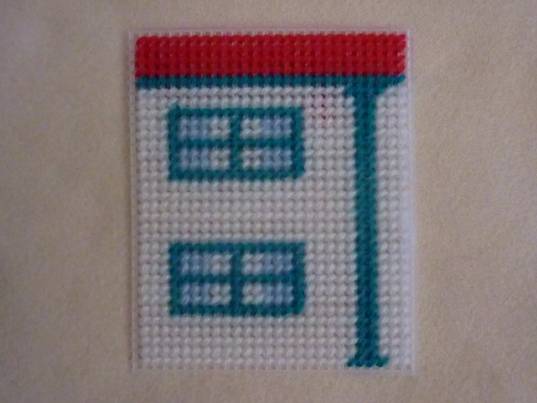
Side panel

The front of the house

The back of the house
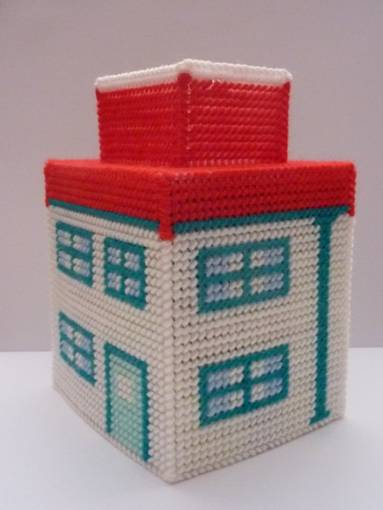
The tissues should pull out of the chimney like puffing smoke.
TIP
If you have got a head cold and a streaming nose and need to keep blowing your nose, take a small pile of kitchen paper and wet the sheets with very diluted disinfectant. If you blow your nose with damp tissues instead of dry ones, you can stop yourself getting sore, red skin on your nose.
Don’t put damp tissues in this box though; lay them on a small water-proof tray.
Please note that the material on this blog is for personal use and for use in classrooms only.
It is a copyright infringement and, therefore, illegal under international law to sell items made with these patterns.
Use of the toys and projects is at your own risk.
©Christina Sinclair Designs 2015

Answers to the News Desk Quiz
- the downward progress of a stream or river = waterfall
- floating but full of water = waterlogged
- someone who works on boats = a waterman
- a mark made in paper during manufacture = a watermark
- a sport played in a swimming pool = water polo
- will not let water in = waterproof

A Thames waterman looking for business
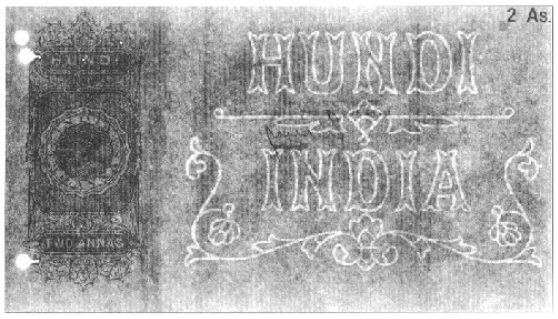
A watermark is inside the paper – you can see it better when you hold it up to the light

Water polo


